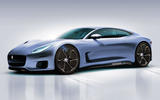Plans to relaunch the Jaguar XK are gathering momentum, with the firm’s head of product strategy confirming that it is working on a proposal for a whole family of sports cars.
Hanno Kirner, who oversees product strategy for the next decade at Jaguar Land Rover (JLR), told Autocar the company remains committed to the sports car segment, despite the Jaguar E-Pace and Jaguar F-Pace SUVs dominating the firm’s sales. In 2017, the F-Pace accounted for two-fifths of all Jaguar sales. The XK was discontinued in 2014.
“The F-Type has been a huge success,” he said. “We love sports cars – and I use the plural quite deliberately. Whether that is delivered by a body variant or something else remains to be seen, but for now let’s just say that the body type is very important for us.”

Kirner’s comments echo those of Jaguar’s head of design, Ian Callum, who has often spoken of his personal desire to develop a family of sports cars. Last year, Callum hinted that work on a re-envisaged XK had begun when he told Autocar: “I want a two-seater [the F-Type] and a 2+2. We’re working on something now. There’s nothing approved, but we instigate in design.”
It is believed that Callum’s team completed a design concept for an XK replacement prior to the second-generation model being axed. However, the latest project is believed to be entirely new and unlikely to be launched until at least 2021.
Both Kirner’s longer-term planning role and his comments suggest the creation of a new sports car family is dependent on JLR’s next-generation platform strategy. Today’s F-Type is based on a heavily modified version of the discontinued XK’s platform and is due for replacement in around 2019. The new F-Type is expected to use a development of that architecture, which is believed to be flexible enough to be adapted back to a 2+2 layout.







Join the debate
Add your comment
not a dsg like Audi use full of troubles
I can see why some Brits like a manual boxes ,but those dsg auto boxes Porche and Audi use ar efull of problems during and after warranty .If you want an auto the conventional 8 and nine speed ZF ones used by BmW and JLR are smooth and reliable.
Porsche Mission E
If there's no electric version, it's going to be left behind, literally.
I dont mind seeing more
I dont mind seeing more models from JLR, but they dont have great history. I looked forward to the F-Type as we read more about it during its developement, but by the time it had arrived, it had become as expensive as the outgoing XK. I looked, but didnt buy one. Just too expensive. There is a market for smaller sports car, in fact there is a good arguement that a sports car should be small with the agility, and performance that comes from small size. Thats where i would like to see JLR, but i doubt we ever will.